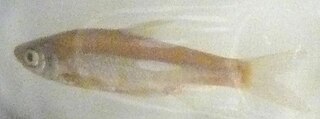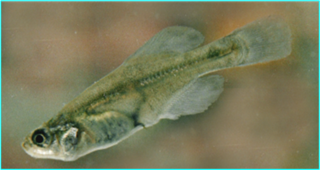
Rhamphochromis is a genus of East African haplochromine cichlids endemic to the Lake Malawi basin, also including Lake Malombe, Lake Chilingali, Chia Lagoon and upper Shire River. They mainly occur in offshore open waters, but a few species also near the coast. They are piscivores that typically feed on lake sardines and small utaka cichlids.

Diptychus is a genus of freshwater ray-finned fish belonging to the family Cyprinidae, the family which includes the carps, barbs and related fishes. This genus is classified within the subfamily Schizothoracinae, the snow barbels. The two species in this genus are found in Himalaya and the Tibetan Plateau of China, India, Nepal and Pakistan, ranging west to the Tien Shan Mountains and Central Asia. The type species is the scaly osman, Diptychus maculatus. The name is derived from the Greek word di, meaning "two", and the Greek word ptyx, meaning "fold". Diptychus is up to 70 cm (2.3 ft) in total length.

Ischikauia is a monospecific genus of freshwater ray-finned fish belonging to the family Xenocyprididae, the East Asian minnows or sharpbellies. The only species in the genus is Ischikauia steenackeri, the wataka, which is endemic to Lake Biwa in Japan. This species was originally described as Opsariichthys steenackeri.

Chelaethiops is a genus of freshwater ray-finned fishes belonging to the family Danionidae, the danionins or danios. The fishes in thuis genus are found in lakes and rivers of Africa. While commonly called "sardines", they are not related to the true sardines of the family Clupeidae.
Engraulicypris is a genus of freshwater ray-finned fish belonging to the family Danionidae, the danionins or danios. This genus is classified in the subfamily Chedrinae and the species in the genus are endemic to Africa. In a study of mitochondrial genealogy, the species formerly included in Mesobola are not phylogenetically separated from Engraulicypris and therefore should also be included in Engraulicypris.

The Chapultepec splitfin, known locally as mexcalpique, is a critically endangered species of fish in the family Goodeidae. It is endemic to Mexico and was originally restricted to lakes and wetlands in the Valley of Mexico, including Lake Texcoco. Through man-made channels it was able to spread to the upper Pánuco River basin. Most native populations disappeared as they were at or near Mexico City, with the waters either being reclaimed, drained, heavily polluted or infested with introduced species. Today the Chapultepec splitfin is only known to survive in three lakes in the Chapultepec park of Mexico City, Lake Xochimilco, Lake Zumpango, Laguna de Tecocomulco northeast of the City where perhaps introduced, and parts of the Pánuco River basin. Most of these remaining populations are small. This species was originally described as Cyprinus viviparus in 1837 by Miguel Bustamante y Septién with the type locality given as "Mexico". In 1860 Pieter Bleeker raised the genus Girardinichthys with a new species Girardinichthys viviparus as its type species, this subsequently proved to be a taxonomy of Cyprinus viviparus.

The Lake Tanganyika sardine is a species of freshwater ray-finned fish in the family Dorosomatidae which was endemic to Lake Tanganyika but which has now been introduced to other lakes in Africa as a food source. It is one of two species within the genus Limnothrissa, the other being the Lake Mweru endemic, L. strappersi. This species and the Lake Tanganyika sprat are known collectively as kapenta.

Gudusia is a genus of freshwater ray-finned fishes belonging to the family Dorosomatidae, the gizzard shads and sardinellas. The fishes in this genus are found in rivers in southern Asia.

Harengula is a genus of marine ray-finned fishes belonging to the family Dorosomatidae, the gizzard shads and sarinellas/ The fishes in this genus occur mostly in the western Atlantic, Gulf of Mexico and the Caribbean Sea, with one species in the eastern Pacific Ocean. There are currently four described species.

Lile, the piquitingas, is a genus of small fish belonging to the family Dorosomatidae, which includes the gizzard shads and sardinellas. They are endemic to the Americas. There are currently four recognized species in the genus.

Microthrissa is a genus of freshwater ray-finned fishes belonging to the family Dorosomatidae, which also includes the gizzard shads and sardinellas. The species in this genus are endemic to Africa.
Nannothrissa is a genus of very small fish in the herring family, Dorosomatidae, endemic to the Congo River system in Africa. There are currently only two recognized species

Odaxothrissa, the fangtooth pellonulines, is a genus of fresh-water fish in the family Dorosomatidae. All the extant species in this genus are found in tropical Africa.

Jinshaia is a genus of freshwater ray-finned fishes belonging to the family Balitoridae, the loaches in this family are commonly known as hillstream loaches although this name also refers to the loaches in the family Gastromyzontidae. These loaches are endemic to China.
Atrilinea is a genus of freshwater ray-finned fishes belonging to the family Xenocyprididae. This is a small genus with three valid species, all of which are endemic to China.

Bangana is a genus of fish in the family Cyprinidae, the carps and minnows. It is distributed across much of southern and eastern Asia. Species live mainly in the flowing waters of tropical and subtropical rivers.
Xenobarbus is a monospecific genus of freshwater ray-fiined fish belonging to the family Cyprinidae. the family which includes the carps, barbs and related fishes. The only species in the genus is Xenobarbus loveridgei which is endemic to Tanzania where it is found in Lake Victoria. The species is rare and only known from a few specimens.

Dorosomatidae is a family of clupeiform fishes. It is now recognized by FishBase as a family in its own right; it had been considered to be a subfamily of Clupeidae. It contains 31 extant genera.

Harenngula clupeola, the false herring, false pilchard or red-ear pilchard, is a species of marine ray-finned fish belonging to the family Dorosomatidae, the gizzard shads and sardinellas. The false herring is found in the Western Atlantic Ocean from eastern Florida and the Bahamas through the Gulf of Mexico south to Santa Catarina in Brazil.
Supradiscus is a genus of freshwater ray-finned fish belonging to the family Cyprinidae, the family which also includes the carps, barbs, minnows and related fishes. The fishes in this genus are endemic to China.















